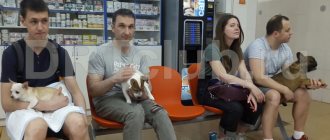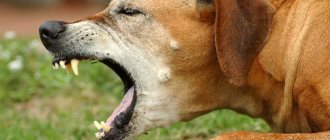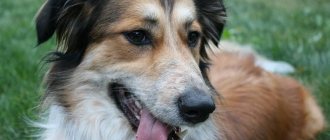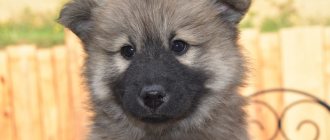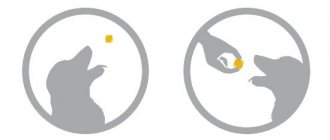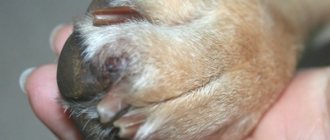Active and curious dogs of any breed often get injured. The risk of injury increases on a walk, where the pet may not get along with other dogs or get hurt by sharp objects. Any wound violates the integrity of the skin and mucous membranes, and the owner should know how to treat the wound and in what case a veterinarian is urgently needed.
Main features
and symptoms of wounds are:
bleeding, pain, separation of the edges of the skin
. It is important to understand that the recovery process directly depends on the speed of first aid and a timely visit to the veterinary clinic, if the case requires it.
From our article you will learn what wounds and types of bleeding there are, how and with what to treat them, what you need to know about healing and how to adjust the diet while your dog is recovering.
Lacerations
A laceration occurs when the integrity of tissue is damaged by sharp objects. These could be: fangs and claws of other animals, a piece of iron or iron wire, a stone. In this case, sharp objects inflict a wound in an oblique direction, in contrast to a cut wound with smooth edges. The skin with such a wound is torn unevenly and diverges into flaps at the edges.
During the examination, the veterinarian can observe torn ligaments, tendons, muscles, blood vessels, fascia (the connective tissue membrane of muscles, organs, vessels, nerves).
What is the danger?
Such a wound becomes a favorable environment for the development of infections, because dirt accumulates on its edges, and torn edges take a long time to heal. There is a high risk of an inflammatory process.
Lacerated wounds are stitched up in a veterinary clinic, where you should go as quickly as possible - before inflammation begins.
When to see a veterinarian
- If the dog is bitten by another animal, there is no way to do without a veterinarian. The animal that caused the injury may be sick or rabid, and this threatens not only the death of the pet, but also infection of family members and other innocent people with a fatal disease.
- Urgent assistance from a veterinarian is necessary if the animal is severely injured, for example, by a fall from a height, hit by a car, has a gunshot or knife wound, beaten, or there is a suspicion of fractures and bruises of internal organs. In such a situation, minutes often count.
- Bleeding from a wound that cannot be stopped also requires veterinary attention.
- Rescue of a dog with an extensive wound on the head can only be organized in a well-equipped clinic, as there may be areas of scalping of the skull, concussion, and damage to the skull. Such injuries need to be accurately diagnosed and treated in a veterinary hospital, as the wounds will need to be sutured, plaster and bandages applied to fractures, and special treatments and strong medications used.
Wounds of the skin and underlying tissues without penetration into cavities and organs can be treated at home.
Purulent wounds
If the wound occurred after surgery and after primary surgical treatment, it is considered clean.
But after injury with sharp, relatively clean objects over a short period of time, the wounds are usually considered infected. When the degree of bacterial contamination is high and a pronounced inflammatory process is observed, the wound begins to fester. Causes of purulent wounds:
- insufficient hygiene when dressing,
- lack of seam care,
- low dog immunity,
- unhealthy diet
- vitamin deficiency.
Symptoms and signs that indicate a purulent process:
- there is swelling around the wound,
- tissues near the wound become hot,
- the dog whines in pain when touched,
- the temperature rises,
- appetite decreases,
- general condition is depressed.
Closed wounds with deep damage and a narrow entrance hole are especially susceptible to suppuration. Because of this, air does not enter the wound, and suitable conditions are created for the proliferation of pathogens.
How to treat purulent wounds
Purulent wounds cannot be ignored.
Be sure to seek help from a veterinarian who will prescribe healing medications and carry out initial treatment. What is the treatment?
- First, the wound is cleaned. To do this, you need to soften the dried crusts with hydrogen peroxide and remove them with sterile material.
- After this, the wound is opened and the accumulated pus is removed from it.
- After cleaning, a healing preparation is applied to the surface of the wound, and then a sterile dressing.
It is important to prevent your dog from tearing off the bandage and licking the wound. A rough tongue when licked will injure the wound again, and the risk of infection will increase. To avoid worrying about this, use a special collar - it will not allow the dog to reach the wound with its tongue.
Dangerous symptoms with purulent wounds
are: fever, lethargy, the dog refusing to eat, convulsions. In this case, it is better not to delay an appointment with a veterinarian - a specialist will select antibiotics and the necessary medications.
Summing up
Complications and risks when a dog is injured can always be eliminated if everything is done correctly, seek veterinary help in a timely manner and carefully follow treatment recommendations. Your dog's injury can happen suddenly. Therefore, you should always be prepared for such a case. The main thing is not to get confused, but to quickly assess the nature of the injury and provide first aid. In case of serious injury, veterinary intervention is inevitable. Always remember that the life and health of your pet is completely in your hands!
Currently reading:
- Thyroid dysfunction in dogs (hypothyroidism)
- What to do if your dog has an abnormal bite
- Primary and important symptoms of rabies in dogs
- Causes of kidney stones in dogs and methods of treatment
Treating a superficial wound
Before you start processing, you must thoroughly wash your hands and treat them with an antiseptic.
How to treat a superficial wound for a pet:
- clean the wound from foreign bodies using tweezers,
- moisten a cotton pad with chlorhexidine and rinse the wound from dirt with light movements,
- use scissors to remove hairs around the wound,
- stop bleeding with hydrogen peroxide,
- treat the edges of the wound with an antiseptic,
- apply a bandage to the wound. You need to press on the wound very carefully so as not to cause unnecessary pain to the dog.
Caring for a sick animal
As with any disease, the animal must be provided with good conditions: water, food, warmth and calm. Caring for dog wounds takes place with special cleanliness and hygiene. It is necessary to change bandages in a timely manner, wash and treat injuries. Be sure to ensure there is no contact with insects. Wound healing in quadrupeds occurs “under the scab.” It is necessary to ensure that the animal does not lick the sore spot. There are special remedies - a bitter bandage. Strictly follow the recommendations of veterinarians!
If you are reading this article, it means that you care about the health of your beloved pet. Having a loving, caring owner, your dog’s illnesses and troubles will quickly pass. Properly help your four-legged friend, and you will soon enjoy fun walks in the park!
Comments on the article
Share this article with your friends
Antiseptics for treating wounds in dogs
When a dog appears in the house, the owner should immediately have a first aid kit in case of emergency. And although most often there is some kind of antiseptic at home for treating wounds, not all drugs for humans are suitable for animals.
Medical antiseptics
, which can be used to treat wounds in dogs:
- Chlorhexidine
An aqueous solution of chlorhexidine at a concentration of 0.05% is suitable. The antiseptic does not penetrate the skin into the bloodstream and does not sting when treating a wound. It can be used on puppies, pregnant or lactating dogs. Chlorhexidine is used to disinfect superficial and deep wounds, scratches, and also treat sutures after operations.
- Miramistin
An antiseptic solution at a concentration of 0.01% is similar in its antimicrobial properties to chlorhexidine and has another advantage. Miramistin helps accelerate tissue healing, reducing inflammation. An antiseptic is used to disinfect deep, open and purulent wounds. Treat burns, scratches, and stitches. Miramistin is also not absorbed into the bloodstream and does not affect the dog’s internal organs. Safe for nursing dogs and puppies of any age. When applied, it does not irritate the skin, but a slight burning sensation is possible, which passes quickly enough.
- Hydrogen peroxide
The main advantage is that peroxide thickens the blood in small vessels, which stops bleeding. The second advantage is the high-quality cleaning of wounds from contamination. When an antiseptic is applied to the wound, abundant foam is formed, which effectively removes dirt, blood, and dead tissue from the wound.
Hydrogen peroxide is used to treat superficial wounds to clean them of dirt and stop bleeding. Further treatment is carried out with other antiseptics: chlorhexidine or miramistin. This is because peroxide prolongs the healing process and harms healthy cells.
- Furacilin
To treat superficial or festering wounds, you can use furatsilin. For disinfection, the antiseptic is used in the form of an aqueous solution at a concentration of 0.02%. If you only have furatsilin tablets at home, you can prepare the solution yourself. To do this, one tablet of furatsilin is dissolved in 100 ml of boiling water and cooled to room temperature before application.
Do not use alcohol solutions to disinfect wounds on dogs.
- they injure healthy cells and cause burns.
Such solutions include iodine and brilliant green
.
Veterinary antiseptics for dogs
Antiseptics for animals are developed in a concentration that is safe for dogs. Veterinary drugs promote rapid wound healing and maintain local immunity. To make applying the antiseptic more convenient, they are produced in the form of a spray.
Before application, the hair around the wound is trimmed. Then, boiled water is used to clean the damaged area from dirt, blood, pus, and dead particles. And only then the product is applied to the wound, covering the healthy area by about 1 cm. After treatment with any antiseptic, it is important not to allow the dog to lick the wound.
A veterinarian will help you choose antiseptics. We advise you to equip your first aid kit with them in advance in order to provide first aid to the animal in a timely manner.
Bleeding in dogs: types and first aid
There are three types of bleeding
in dogs:
- Capillary
: blood oozes over the entire surface of the wound. The bleeding is not profuse, so it does not pose a great danger to life.
First aid for capillary bleeding
: wash the wound from dirt with chlorhexidine, stop the bleeding with hydrogen peroxide, apply a sterile bandage. The dog owner can handle the treatment of a wound with such bleeding on his own.
- Venous
: dark-colored blood flows in a stream from the wound canal.
First aid for venous bleeding
: A pressure bandage is applied to the wound. To do this, you can use a hard object, first wrapping it in sterile gauze or bandage. A tourniquet is applied above the injury site. It is important to maintain pressure on the wound so that the bleeding does not increase. When the tourniquet is applied correctly, the pulse on the injured limb cannot be felt. For further assistance, the dog must be taken to a veterinary clinic.
- Arterial
: bright scarlet blood spurts out of the wound in a stream.
First aid for arterial bleeding
: This type of bleeding is stopped with a tourniquet. Such improvised means as a belt, scarf, collar are suitable. It is important to record the time the tourniquet is applied and take your pet to the veterinarian as soon as possible. In winter, the tourniquet can be kept for up to 1 hour, in summer - up to 30 minutes. After this time, the tourniquet is loosened for 3 minutes.
To slow down the inflammatory processes, in case of any bleeding, apply a cold compress to the wound. Apply cold for 30 minutes and repeat the procedure several times.
Other therapeutic techniques
It would be somewhat naive to think that it is enough to just stitch a serious wound. Treatment is usually much more serious. Since in all these cases the wound channel is inevitably subject to bacterial contamination, the animal is prescribed broad-spectrum antibiotics
Sometimes (at the veterinarian's discretion) anti-inflammatory corticosteroids may be prescribed. But when treating very severe wounds, when the rehabilitation period can last for several weeks, this is contraindicated: with prolonged use, these drugs provoke the development of fungal infections, so it’s not worth the risk. In addition, to improve and speed up the regeneration process, it is useful to prescribe multivitamin complexes. They improve metabolism, accelerate the production of leukocytes, strengthening the dog’s body’s defenses. In addition, bandages and tampons soaked in Vishnevsky’s balsamic liniment can be applied to the wounds themselves (and even more so torn ones).
Important! If you don’t know how to treat a wound received by your pet, you can use streptocide powder for this purpose. It perfectly disinfects the wound surface and prevents the development of purulent inflammation in the future.
In addition, if the wound occurs after a fight with another dog or other animal, rabies vaccines (i.e., anti-rabies medications) may be necessary. This is especially true for hunting dogs who may encounter rabid foxes. But! This only applies to those dogs that were not vaccinated against rabies on time. Unfortunately, this also happens. In this case, all costs associated with obtaining vaccines and serums fall on the shoulders of the animal owner.
Wound healing process in dogs
The changes that consistently develop in the wound and surrounding tissues are called the wound healing process or wound process. There are three phases of healing
:
Inflammatory phase
. Starts from the moment the damage is received and lasts up to 5 days. During vascular changes that occur after injury, traumatic edema develops. Then the wound is cleansed of necrotic tissue, and after 5-6 days most of the inflammatory reaction is stopped.
Phase of regeneration, formation and maturation of granulation tissue
. Includes three processes that occur simultaneously:
- Formation of collagen
, which, together with fibrous structures, eliminates tissue defects and ensures the strength of the scar. - Growth of blood and lymphatic vessels
. New capillaries actively grow and the patency of previously existing ones is restored, thereby ensuring blood supply to new tissues. - Epithelial growth
. Epithelial tissue grows from the edges of the wound to the center. Swelling and inflammation of the wound go away, and the release of wound fluid stops.
Scar formation and scar reorganization phase.
The wound healing is completed. Collagen fibers form the scar.
What affects the healing time?
- size of the wound,
- degree of tissue damage,
- presence of infection in tissues,
- pet's health status,
- age,
- presence of diseases,
- quality of therapy.
There are different types of wound healing depending on the presence of contamination, infection and the nature of the injury. There are three types
:
- Healing by primary intention
Healing by primary intention occurs in a relatively short time and is characterized by the joining of the wound edges without visible intervening tissue through the growth of connective tissue in the wound channel. This is possible for wounds with clean and smooth edges that are free of necrotic tissue, hematomas and infections.
With such healing, a scar most often does not form. Healing according to the primary type is considered the most favorable; the functions of damaged tissues are completely restored. This type of healing is used to heal wounds after operations or fresh wounds that have undergone surgical treatment.
- Healing by secondary intention
If healing is hampered by tissue defects (the edges of the wound are far from each other), infections, or circulatory disorders, then this type of healing will be secondary. In such wounds, suppuration forms, which helps to cleanse the wound. Granulation tissue develops - a special type of connective tissue that has a fine-grained structure. The surface layer of granulation tissue prevents infection from entering the wound.
The wound decreases in volume and epithelization begins. By the end of the healing process, the wound is completely covered with granulations, the edges and walls of the wound are reduced, and epithelization is completed. Gradually, granulation tissue transforms into connective tissue, and a scar is formed.
- Healing under the scab
After a wound, blood begins to clot, which dries and forms a scab (crust). The scab protects the wound from infections and has a beneficial effect on the healing process. Only superficial wounds (abrasions, scratches) heal under the scab. The wound heals in about 7 days, and rapid epithelization occurs. Then the crust disappears.
